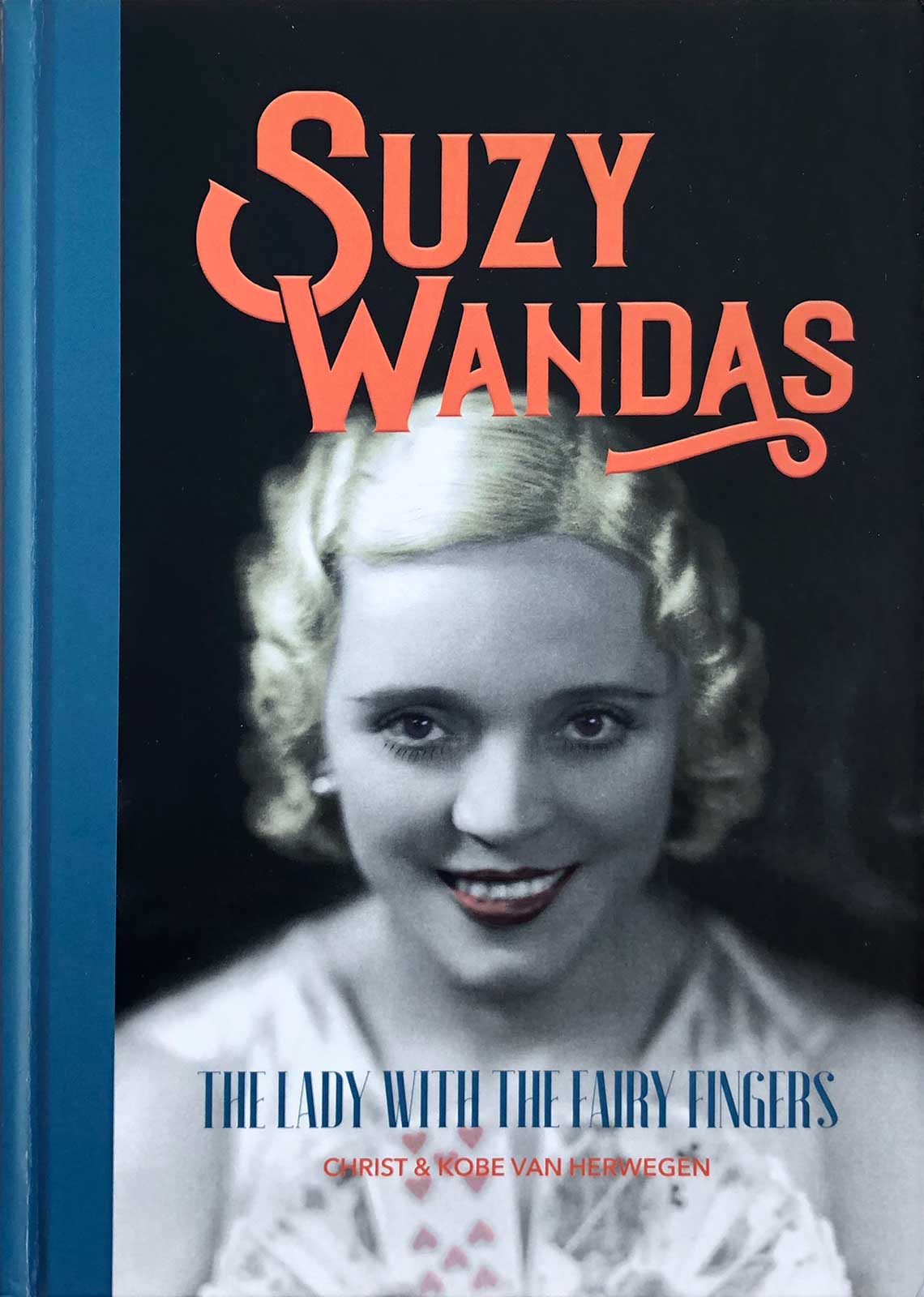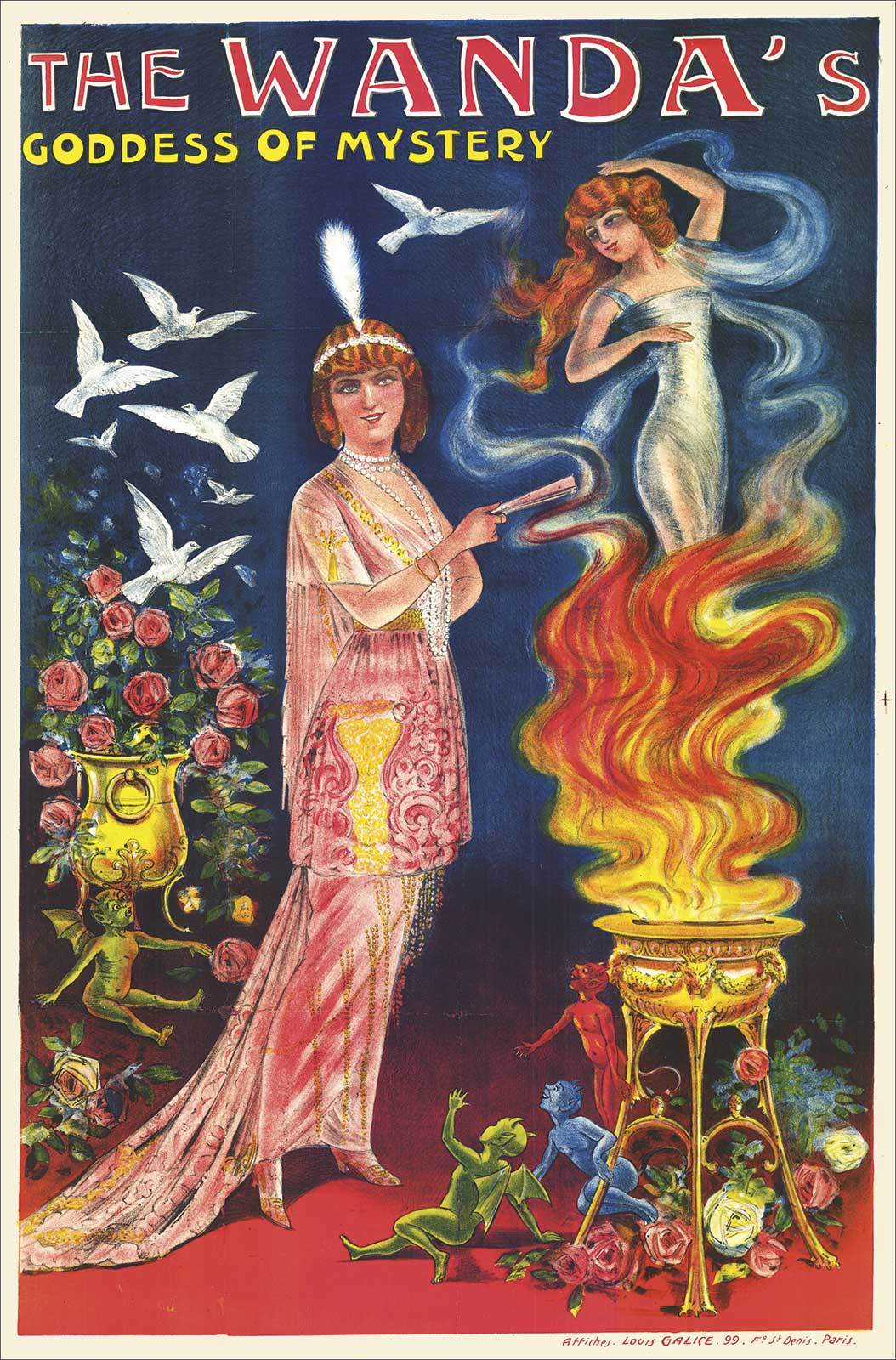Suzy Wandas – The Lady with the Fairy Fingers
04-10-2020
The Nielsen Gallery
For eleven years and four months, between January 2006 through May 2017, Nielsen Magic in collaboration with MUM Magazine (the official publication of the Society of American Magicians) and various authors, had a column titled “The Nielsen Gallery”. Each month a vintage magic poster was featured in the magazine, along with biographical information about the magician on the poster.
There were one hundred thirty-five posters featured in the column throughout the years. A future project in the next couple of years will be to compile those columns, add 15 more posters to complete 150 images, and re-publish all the essays. To this, we plan to add a biography of Norm Nielsen. It will be a challenging project indeed.
“Suzy Wandas – The Lady with the Fairy Fingers” Book

About a month ago, we received a few copies to sell of a brand new book in the market. It is titled: “Suzy Wandas – The Lady with the Fairy Fingers” written by Christ and Kobe Van Herwegen. For those of you who have not heard of her, she was one of the top sleight of hand performers in the 20th century. Her grace and skill were legendary.
After a successful career in Europe, she married Dr. Zina Bennett, a doctor, amateur magician and president of the S.A.M., from the United States.
Upon receiving the book, I remembered that Tom Ewing wrote a brief biography of “The Wandas Sisters” on the March 2010 issue of MUM Magazine.
We are currently selling both the BOOK and the ORIGINAL WANDA’S POSTER. Click on the links or images to find out more about them.

In the meantime, enjoy a reprint of the March 2010 MUM Nielsen Gallery Article:
The Wandas Sisters
This month’s poster features The Wandas, a mother and daughter magic and dance act that was extremely popular throughout Europe in the first three decades of the last century. The act featured Elizabeth Van Dyk Wandas and her daughter Suzy who billed themselves as “The Wandas Sisters” and who were considered by critics and the public as two of the best female magicians in the world.
Elizabeth was born in Steelandt, Belgium and entered show business when she married Charles-Louis Van Dyk, a member of the Van Dyk Brothers, who offered music, balancing, magic and puppetry shows across Belgium. A talented painter and designer, Van Dyk created a traveling theater dedicated to magic and under the pseudonym of Charles Wandas, performed with his new bride Elizabeth.
In the show, Elizabeth appeared as the “Queen of Flowers” and performed a production act that left the stage covered in a riot of colorful flowers. The couple’s first child Jean, who later assumed the stage name of “Suzy,” was born in Brussels in 1896, and shortly thereafter, her brother Louis was born. As children, they received both regular educations as well as strong artistic training in music, dance, acrobatic dexterity and, of course, magic.
Biographer Rene Jadot described Suzy’s childhood and introduction into magic:
Effectively, born of artist and magician parents, the first thing little Suzy saw in her cradle was magic. Before her eyes, things appeared and disappeared, silks tied and untied themselves mysteriously, and the whole series of magical transformations were passing in front of her eyes during the father’s rehearsals. Boxes, cages, tubes, shining chromed rings and all the variously colored stage materials of the parents were the little fairy universe of the child in the very first years of her life. Thus as a mere child Suzy was marked by what was going to be for her the most beautiful job in the world: MAGICIAN.
She was particularly talented and soon was part of her parents show featuring violin, dance, tap dance, vocal imitations, and some limited magic. Her father was a friend of T. Nelson Downs, the King of Coins, and he was one of her first instructors when she was only eight years old. She was also inspired by the manipulation act of Mercedes Talma, The Queen of Coins. One sketch she performed in 1910 was “The Devil’s Dinner” in which she produced table settings, bottles, wine, food and other objects from two numbered and empty tubes (an effect known as the “Organ Pipes”). The family continued to travel throughout Belgium, Holland, Luxembourg and France until Charles-Louis Wandas died unexpectedly on March 3, 1911.
At this point Elizabeth abandoned the traveling theater and devoted herself entirely to music hall performances with she and Suzy doing music, dance and magic and Louis playing the comic role of bellhop. The act consisted of the spectacular disappearance and reappearance of an assistant’s gloves; color changing scarf through a paper tube; scarf burned up in paper ball and rediscovered tied between two others in a glass; excelsior balls (billiard ball manipulations); Devil’s Dinner; card and coin manipulations, and a giant production of flags, flowers, and other items.
The dawn of World War I in Central Europe in 1914 caught the family by surprise and in 1916, the departure of Louis, at the age of 16, as a volunteer in the Belgium army, forced Elizabeth and her daughter Suzy to create “The Wandas Sisters.” Louis’ injuries during the war prevented him from ever performing again. Max Diff, a member of l’Association Française des Artistes Prestidigitateurs, described their act in the May 1973 New Tops.
In 1923, they performed in a black setting, decorated with a gold design; in the back of the stage, three urns were placed on a stand in front of which there was a large golden vase. The two ‘sisters’ performed together the excelsior balls with much elegance; the tambourine with production of bunches of flowers, scarves, then a long silk multicolored banderole. Suzy, costumed as a gypsy, seized the banderole and while dancing, spun it around her forming iridescent spirals. All during the act the urns were constantly emptied of the water they contained into the vase and nevertheless, were always rediscovered to be full. From the container full of water (the vase), Elizabeth and Suzy produced large bunches of flowers which they planted on the floor to create an iridescent flower-bed and, finally, a huge flag hoisted toward the arch (of the stage).
What made the act so sensational was that their magic and especially card, coin, and billiard ball manipulations were performed in sleeveless evening gowns. This was particularly impressive during the Excelsior Billiard Ball portion where in rapid fire, billiard balls vanished from one sister’s hands only to appear in the others and finishing with both women’s hands full of billiard balls. The Journal Comoedia noted they were the only women to present their manipulations with bare arms and called them, “…gracious and marvelous artists.”
In 1936, Elizabeth decided to retire after more than 20 years before an adoring public. Suzy then perfected and created a stylized manipulative act that catapulted her to the top bill of music halls and theaters. Even well-versed magic enthusiasts were impressed and deceived by her cigarette, coin, and card productions that appeared and vanished in her fingertips. One could only watch in vain for her steals and search for her secrets. One day a manager gave her a title by which she would be known from that time onward, “The Lady with the Fairy Fingers.”
Suzy first appeared in the United States in September 1953 during the Abbott’s Get-Together in Three Rivers, Michigan. H. Adrian Smith described her act as, “…superb sleight-of-hand, meticulous to the last detail, but a true exhibition of showmanship.” He attributed much of her polish and success from the lessons she received from her mother.
Elizabeth was visiting Antwerp to be installed in the Antwerp Magic Circle as the “Dean of Belgium Magicians,” an honor unique in the history of conjuring and one which attested to her great skill, her position in the magical world, and her personal standing among Belgian magicians. A medal was struck in her honor and a diploma was to be presented to her during a ceremony by the president of the Circle. At the event she became ill, was taken to the hospital, but went into a coma and never recovered. Suzy was in Nice, France at the time.
Suzy retired from magic in 1959 and within three months married Dr. Zina B. Bennett, a doctor from Detroit, Michigan and national S.A.M. president. They met during her first tour of the U.S. in 1953. At the S.A.M. convention in Chicago in 1975 she was elected as a living member of the S.A.M. Hall of Fame. In 1981, she received a Performing Fellowship from the Academy of Magical Arts. Wandas died on July 12, 1986 at 90 years of age.
(Wandas article written by Tom Ewing)
-Lupe Nielsen
(October 4, 2020)